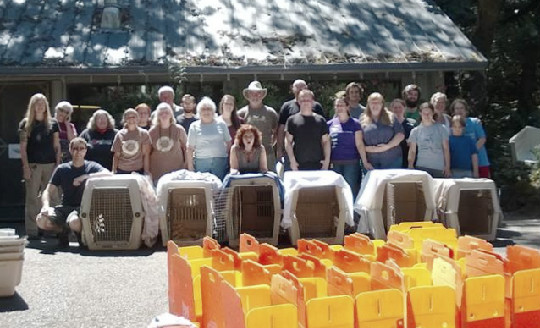A fire incident that occurred on the afternoon of August 7 near Spencer Butte, Eugene, Oregon caused a gutted house, several burnt vehicles and charred trees. Fortunately, no one was injured in the fire and firefighters managed to prevent the fire from spreading. Located northeast of Spencer’s Butte, Cascades Raptor Center (CRC) decided to execute their evacuation plan the moment Executive Director Louise Shimmel saw a billowing plume of smoke a quarter mile away from the center.
How important is it to have a disaster preparedness plan?
“Extremely important,” said Shimmel. CRC’s detailed emergency action plan was put together by a graduate student at the University of Oregon who had past work experience with Red Cross. The Eugene Fire Department also inspected the center and gave their feedback, such as regulating parking spaces onsite for emergency vehicles and installing a staging area for staff and volunteers to meet and decide the next course of action during an emergency. According to Lane County’s Fire Safety Standards for Roads and Driveways, driveways should be at least 20 feet wide to allow access for fire fighting vehicles and turnaround as well, which CRC already has.
“In general consideration of state fire prevention guidelines, there were some things we could do and others we could not. We try to maintain a 13-foot high ceiling for fire trucks to get in but we don’t have a 30-foot perimeter around the buildings,” Shimmel said. “We want a comfortable habitat here for birds but that puts us more at risk.

As part of implementing the action plan, CRC’s volunteers helped build an emergency shed (generously funded by one of their volunteers) that stored supplies such as walkie-talkies and collapsible carriers for animals; marked drawers containing vital information and set up a backup procedure for their computers. Quarterly assessment checks on all batteries were carried out as well.
“It’s kind of hard to do a fire drill when you know that it isn’t real. But in this case, it was real,” Shimmel explained.
On the day of the fire, there were only eight people at the center; after activating the phone tree, another 19 volunteers and staff were there within 20 minutes to help with the evacuation. CRC’s Education Director, Kit Lacy, directed the evacuation plan: sprinklers on the side of the property toward the fire were turned on; with some 100 birds on site, dozens of carriers and transport boxes were put together and set up with towels and with sheets to cover them; any equipment with gasoline and any combustible items like oxygen tanks were moved away from the buildings; critical file and medical supply drawers were emptied, packed, and loaded into vehicles; computers were backed up.
Shimmel was grateful for the efficient fire and police response during the incident, and particularly their understanding and support of the magnitude of CRC’s evacuation requirements. Some of the roads leading to the butte were blocked to prevent traffic from entering, but police allowed responding volunteers through. A police officer was stationed near the driveway to CRC, keeping staff and volunteers in contact with the fire response effort. Just as volunteers were about to start loading birds into carriers, the police officer informed them the fire was contained, and staff decided to stand down. From start of activating the phone tree to the finish of putting away all the carriers, files, equipment, the whole exercise took about two hours. Staff had previously estimated – though without a fire drill to be sure – that it would take about two hours to get everybody ready to leave, depending on how many birds were on site and how many staff and volunteers were here to assist.”
What could have been done differently?
“Part of our plan is to, if necessary, simply release any flighted bird. When it came down to contemplating that, it’s clear that we would need to install release hatches on bird cages, instead of opening the doors and expecting them to fly down from 20 feet to 8 feet and then fly out,” Shimmel said.
What should all wildlife centers have in place?
Shimmel stressed the importance of a disaster preparedness plan for other situations (not merely fires) and having supplies set aside for emergencies – supplies that are not for daily use, but only for emergencies, even though that requires duplication. Regular checks should be done on batteries for electrical equipment such as walkie-talkies. A reciprocal agreement with other rehabilitation centers within the same area should be planned in case animals need to be held at another shelter if the center is not safe or has been damaged. Smoke detectors should be installed in all buildings along with frequent checks on the batteries.
The next imperative step is to have designated organization staff that are aware of the emergency plan and who know how to initiate it during an emergency. “We have staff here all the time along with volunteers, so they will know our plans and how to put it in action,” Shimmel said. Prevention is always better than cure – she contacts the non-emergency police and fire dispatch whenever she or anyone from CRC hears sirens nearby or a helicopter in the area, just to make sure it is not a hazardous incident that will affect the center.

At the end of the day, Shimmel was thankful that the fire did not affect the center directly and that the preparedness plan worked out despite not testing it out previously – post-event evaluations collected from everyone who assisted have also led to some good suggestions on how to improve the plan. “We had a good crew here who knew what to do. Everyone was so shaky afterwards. Adrenaline is tough,” she said. “It was, in the end, a good experience.”

Leave a Reply
You must be logged in to post a comment.